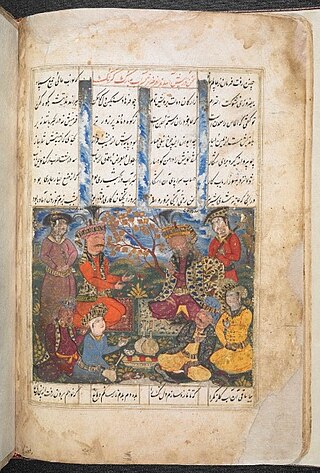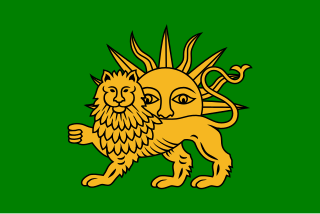Related Research Articles

Abbas I, commonly known as Abbas the Great, was the fifth shah of Safavid Iran from 1588 to 1629. The third son of Shah Mohammad Khodabanda, he is generally considered one of the greatest rulers of Iranian history and the Safavid dynasty.

Armenians are an ethnic group and nation native to the Armenian highlands of West Asia. Armenians constitute the main population of the Republic of Armenia and constituted the main population of the unrecognized Republic of Artsakh until the Armenians of Nagorno-Narabakh were ethnically cleansed. There is a wide-ranging diaspora of around five million people of full or partial Armenian ancestry living outside modern Armenia. The largest Armenian populations today exist in Russia, the United States, France, Georgia, Iran, Germany, Ukraine, Lebanon, Brazil, Argentina, Syria, and Turkey. The present-day Armenian diaspora was formed mainly as a result of the Armenian genocide with the exceptions of Iran, former Soviet states, and parts of the Levant.

The Karabakh Khanate was a khanate under Iranian and later Russian suzerainty, which controlled the historical region of Karabakh, now divided between modern-day Armenia and Azerbaijan. In terms of structure, the Karabakh Khanate was a miniature version of Iranian kingship. The administrative and literary language in Karabakh until the end of the 19th century was Persian, with Arabic being used only for religious studies, despite the fact that most of the Muslims in the region spoke a Turkic dialect.

The Armenian highlands is the most central and the highest of the three plateaus that together form the northern sector of West Asia. Clockwise starting from the west, the Armenian highlands are bounded by the Anatolian plateau, the Caucasus, the Kura-Aras lowlands, the Iranian Plateau, and Mesopotamia. The highlands are divided into western and eastern regions, defined by the Ararat Valley where Mount Ararat is located. Western Armenia is nowadays referred to as eastern Anatolia, and Eastern Armenia as the Lesser Caucasus or Caucasus Minor, and historically as the Anti-Caucasus, meaning "opposite the Caucasus".
Qizilbash or Kizilbash were a diverse array of mainly Turkoman Shia militant groups that flourished in Azerbaijan, Anatolia, the Armenian highlands, the Caucasus, and Kurdistan from the late 15th century onwards, and contributed to the foundation of the Safavid dynasty in early modern Iran.

Islam began to make inroads into the Armenian Plateau during the seventh century. Arab, and later Kurdish, tribes began to settle in Armenia following the first Arab invasions and played a considerable role in the political and social history of Armenia. With the Seljuk invasions of the eleventh and twelfth centuries, the Turkic element eventually superseded that of the Arab and Kurdish. With the establishment of the Iranian Safavid dynasty, Afsharid dynasty, Zand Dynasty and Qajar dynasty, Armenia became an integral part of the Shia world, while still maintaining a relatively independent Christian identity. The pressures brought upon the imposition of foreign rule by a succession of Muslim states forced many lead Armenians in Anatolia and what is today Armenia to convert to Islam and assimilate into the Muslim community. Many Armenians were also forced to convert to Islam, on the penalty of death, during the years of the Armenian Genocide.
Iranian Armenians, also known as Persian Armenians, are Iranians of Armenian ethnicity who may speak Armenian as their first language. Estimates of their number in Iran range from 70,000 to 500,000. Areas with a high concentration of them include Tabriz, Tehran, Salmas and Isfahan's Jolfa quarter.

The Nakhichevan Khanate was a khanate under Iranian suzerainty, which controlled the city of Nakhichevan and its surroundings from 1747 to 1828.
The Treaty of Zuhab, also called Treaty of Qasr-e Shirin, was an accord signed between the Safavid Empire and the Ottoman Empire on May 17, 1639. The accord ended the Ottoman-Safavid War of 1623–1639 and was the last conflict in almost 150 years of intermittent wars between the two states over territorial disputes. It can roughly be seen as a confirmation of the previous Peace of Amasya from 1555.

The Aq Qoyunlu or the White Sheep Turkomans was a culturally Persianate, Sunni Turkoman tribal confederation. Founded in the Diyarbakir region by Qara Yuluk Uthman Beg, they ruled parts of present-day eastern Turkey from 1378 to 1503, and in their last decades also ruled Armenia, Azerbaijan, much of Iran, Iraq, and Oman where the ruler of Hormuz recognised Aq Qoyunlu suzerainty. The Aq Qoyunlu empire reached its zenith under Uzun Hasan.

Allahverdi Khan was an Iranian general and statesman of Georgian origin who, initially a gholām, rose to high office in the Safavid state.

The Peace of Amasya was a treaty agreed to on May 29, 1555, between Shah Tahmasp of Safavid Iran and Sultan Suleiman the Magnificent of the Ottoman Empire at the city of Amasya, following the Ottoman–Safavid War of 1532–1555.
The majority of the population of Iran consists of Iranic peoples. The largest groups in this category include Persians and Kurds, with smaller communities including Gilakis, Mazandaranis, Lurs, Tats, Talysh, and Baloch.

Safavid Iran or Safavid Persia, also referred to as the Safavid Empire, was one of the largest and long-standing Iranian empires after the 7th-century Muslim conquest of Persia, which was ruled from 1501 to 1736 by the Safavid dynasty. It is often considered the beginning of modern Iranian history, as well as one of the gunpowder empires. The Safavid Shāh Ismā'īl I established the Twelver denomination of Shīʿa Islam as the official religion of the empire, marking one of the most important turning points in the history of Islam.

Qarachaqay Khan was a military commander in Safavid Iran of Armenian origin. He was known for his great collection of porcelain items and loyal service to Shah Abbas I. Qarachaqay Khan was killed while commanding an expedition against the Georgian rebels.

Qajar Iran, also referred to as Qajar Persia, the Qajar Empire, Sublime State of Persia, officially the Sublime State of Iran and also known as the Guarded Domains of Iran, was an Iranian state ruled by the Qajar dynasty, which was of Turkic origin, specifically from the Qajar tribe, from 1789 to 1925. The Qajar family took full control of Iran in 1794, deposing Lotf 'Ali Khan, the last Shah of the Zand dynasty, and re-asserted Iranian sovereignty over large parts of the Caucasus. In 1796, Agha Mohammad Khan Qajar seized Mashhad with ease, putting an end to the Afsharid dynasty. He was formally crowned as Shah after his punitive campaign against Iran's Georgian subjects.
The Mirimanidze family were a Georgian noble family of Armenian ethnicity whose members rose in prominence in the service of Safavid Iran. Hailing from Somkhiti, the clan produced numerous high-ranking figures in the Safavid state, and especially flourished in the 17th century, during the reign of the kings Abbas I, Safi and Abbas II. Due to the complex character of the family's identity, they were often described in different terms by contemporaneous historians. In the late Safavid era, Hosaynqoli Khan, vali (governor) of Kartli, confirmed the family as belonging to the t'avadi.

Sultan-Agha Khanum also in Western sources Corasi was a Safavid queen consort of Kumyk origin, as the second wife of Safavid king Tahmasp I.
Literature in Iran encompasses a variety of literary traditions in the various languages used in Iran. Modern literatures of Iran include Persian literature, Azerbaijani literature, and Kurdish literature, among others.

The Erivan Province, also known as Chokhur-e Sa'd, was a province of Safavid Iran, centered on the territory of the present-day Armenia. Erivan (Yerevan) was the provincial capital and the seat of the Safavid governors.
References
- ↑ Kołodziejczyk 2017, p. 21.